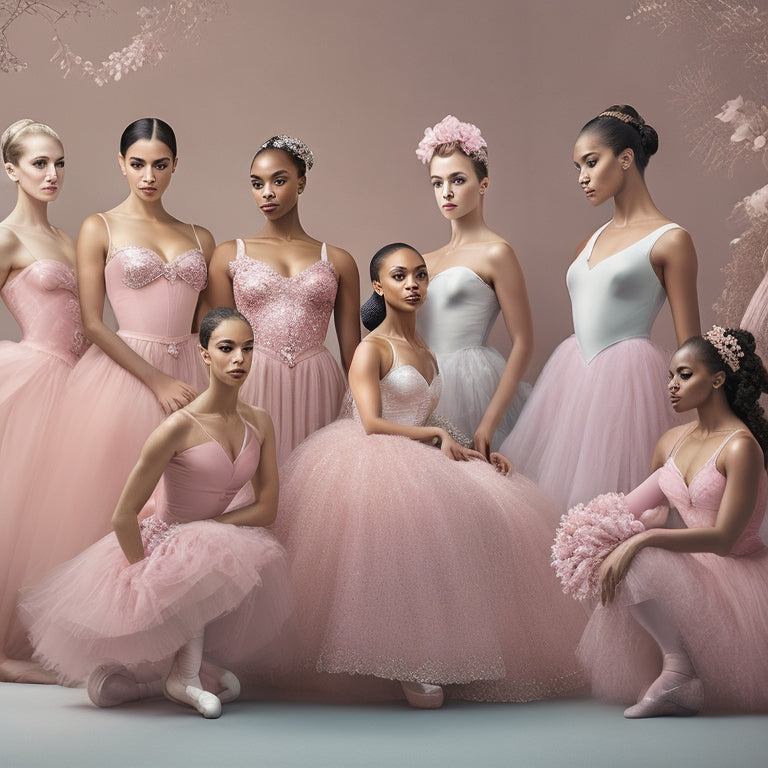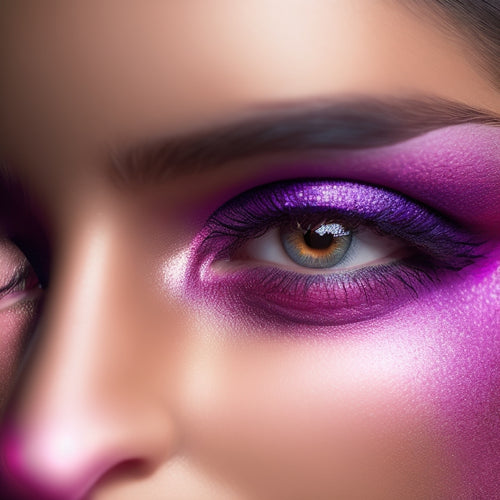
Are All Ballerinas Flat Chested?
Share
You've likely been misinformed if you think all ballerinas conform to a specific, slender body type with minimal curves. This stereotype may have originated from early 20th-century ballet icons, but it's far from reality. Professional ballet dancers come in various shapes and sizes, with different body types suited to different roles. Flexibility, strength, and nutrition habits are essential for success, not a specific physique. In fact, diverse ballerinas have successfully defied traditional stereotypes. You'll find that the world of ballet is more complex and multifaceted than you might have thought - and there's more to explore.
Key Takeaways
• The stereotype of flat-chested ballerinas originated from early 20th-century ballet era and was reinforced by media portrayal.
• Professional ballet dancers come in various shapes and sizes, with different body types suited to different roles.
• There is no one "ideal" body type for ballet; dancers with muscular, petite, long and lean, and curvy physiques can all succeed.
• Real-life examples of diverse ballerinas, such as Misty Copeland and Sylvie Guillem, defy traditional stereotypes and prove success isn't limited to a specific mold.
• The ballet world is embracing body positivity and racial diversity, recognizing that unique physiques can be an asset, not a limitation.
The Origins of the Stereotype
The stereotype that all ballerinas are flat-chested may have originated from the early 20th-century ballet era, when dancers like Anna Pavlova and Tamara Karsavina were celebrated for their slender, androgynous physiques. You might wonder how this stereotype formed and persisted.
Stereotype formation often involves oversimplification and exaggeration, and in this case, the media played a significant role. The media's portrayal of ballerinas, particularly in films and photographs, often featured dancers with petite, athletic builds, reinforcing the idea that all ballerinas conform to this standard.
This narrow representation contributed to the widespread assumption that a ballerina's body must be flat-chested to be successful. As you explore this topic, consider how media portrayal influences our perceptions and shapes our understanding of what it means to be a ballerina.
Body Types in Professional Ballet
As you explore the world of professional ballet, you'll discover that body types vary widely, debunking the myth that all ballerinas conform to a single, flat-chested mold. In reality, professional ballet dancers come in all shapes and sizes, with varying body types suited to different roles.
| Body Type | Characteristics | Ideal Roles |
|---|---|---|
| Muscular | Strong, athletic build | Principal, Corps de Ballet |
| Petite | Small, delicate frame | Soloist, Principal |
| Long and Lean | Tall, slender build | Principal, Soloist |
| Curvy | Voluptuous, hourglass figure | Character, Corps de Ballet |
A dancer's body type can influence their career path, but it's not the only factor. Nutrition habits and injury prevention also play a pivotal role in a dancer's success. By focusing on these aspects, dancers can optimize their performance and extend their careers.
The Importance of Flexibility and Strength
Developing flexibility and strength is crucial for professional ballet dancers. It allows them to master intricate movements and maintain precise control over their bodies. As dancers work towards technical excellence, prioritizing flexibility and strength training is essential to achieve peak performance.
This requires a well-rounded approach that includes:
-
Core control: Building strong core muscles enables dancers to maintain balance, stability, and control during complex movements.
-
Muscle balance: Developing balanced strength in muscles ensures efficient execution of movements, reducing the risk of injury.
-
Injury prevention: Strengthening muscles and improving flexibility helps prevent common ballet injuries, allowing dancers to perform with freedom and confidence.
Real-Life Examples of Diverse Ballerinas
From Misty Copeland's athletic build to Sylvie Guillem's lithe frame, diverse ballerinas have defied traditional body type stereotypes, proving that success in ballet isn't limited to a specific physical mold.
You may not fit the traditional ballerina mold, but that doesn't mean you can't excel in ballet. Take, for example, the powerful and curvy bodies of ballerinas like Lauren Anderson and Tai Jimenez, who are redefining what it means to be a ballerina.
The ballet world is gradually embracing body positivity, celebrating racial diversity, and recognizing that beauty comes in many shapes and sizes. As you explore the world of ballet, remember that your unique physique can be an asset, not a limitation.
Breaking the Mold in Ballet Company
You can defy traditional ballet company standards by joining a company that actively seeks to break the mold, such as the Dance Theatre of Harlem or the National Ballet of Canada. These companies are redefining beauty and challenging norms, providing a platform for diverse ballerinas to thrive.
By joining such companies, you can:
- Experience inclusive casting, where physicality isn't the only criteria for roles.
- Perform in productions that celebrate individuality, showcasing unique styles and strengths.
- Be part of a community that values diversity, fostering a culture of acceptance and empowerment.
In these companies, you'll find a supportive environment where you can grow as an artist and challenge traditional ballet norms. Redefine what it means to be a ballerina and break free from conventional standards.
Frequently Asked Questions
Do Ballet Shoes Come in Different Sizes for Different Foot Types?
As you lace up, you'll find ballet shoes come in various sizes to cater to different foot types, including yours, with considerations for foot arch support and toe support to guarantee a comfortable, liberating fit.
Can Ballerinas Have Any Tattoos or Body Piercings?
You wonder if ballerinas can have tattoos or piercings, and the answer is, it depends on the company's policy, but many dancers balance their body art with their dance identity, embracing self-expression while maintaining professionalism.
Are There Any Male Ballet Dancers, or Is It Only for Women?
As you step into the 21st-century ballet scene, you'll discover that male ballet dancers, defying traditional male stereotypes, are thriving, shattering gender roles, and redefining the art form with elegance and strength.
How Long Does It Take to Become a Professional Ballet Dancer?
You'll need around 8-10 years of rigorous ballet training and dance education to become a professional ballet dancer, dedicating yourself to daily classes, rehearsals, and performances to master the craft.
Can Ballet Dancing Help With Weight Loss and Overall Fitness?
You'll be thrilled to know that 83% of ballet dancers report significant weight loss and improved overall fitness! Ballet dancing can indeed help with weight loss and overall fitness by building core strength, which supports your fitness goals and sets you free to achieve a healthier, stronger you.
Related Posts
-

Why Digital Solutions Are a Game-Changer
By integrating digital solutions into your operations, you can revolutionize your workflows, discover new revenue str...
-

What Makes a Stunning Lyrical Dance Makeup Look?
You craft a stunning lyrical dance makeup look by balancing ethereal, emotive essence with subtle, shimmering accents...
-

Captivating Insights: Maos Last Dancer Analysis
Li Cunxin's memoir, Mao's Last Dancer, is a compelling narrative that delves into the intersection of art, identity, ...


